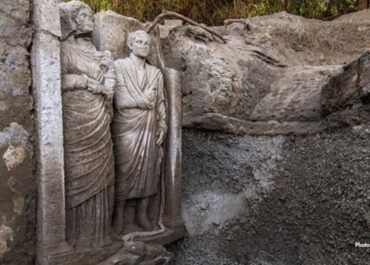
A Life-Sized relief of a married couple emerges from a Tomb at Pompeii’s Porta Sarno
A remarkable discovery has just been made in Pompeii: a nearly life-sized funerary relief depicting a man and a woman, likely a married couple, has been unearthed at the Porta Sarno necropolis. This extraordinary find comes from the “Investigating the Archaeology of Death in Pompeii” research project, a collaboration between the Archaeological Park of Pompeii and the University of Valencia under the scientific direction of Professor Llorenç Alapont.
Ready to step into the wonders of Pompeii yourself?
Enhance your experience by booking our Pompeii, Wine Tasting, and Sorrento Tour. Explore the ancient ruins with a private guide, indulge in local wines, and discover the beauty of Sorrento—all in one unforgettable day!
The newly discovered relief was found during excavations launched in July 2024 in an area previously disturbed by the 1990s construction of the Circumvesuviana railway’s double track. Initial digs in 1998 had already revealed over 50 cremation burials, marked by steles and a funerary arch monument. However, this latest excavation revealed something even more impressive: a monumental tomb featuring a large wall with multiple niches, crowned by the high-relief sculptures of the man and woman.
The craftsmanship is stunning. The woman’s sculpted accessories suggest she may have been a priestess of Ceres, the Roman goddess of agriculture. The refined detail and stylistic features of the relief hint at a Late Republican period origin, making it a rare and invaluable addition to the existing body of Roman funerary art.
The two sculptures have been carefully moved to the Palestra Grande within the Pompeii archaeological site, where they will undergo a meticulous restoration process. Excitingly, visitors will have the unique opportunity to witness parts of the restoration live during the upcoming exhibition, “Being a Woman in Ancient Pompeii,” opening on April 16. This exhibition promises to offer powerful insights into the lives and roles of women in Roman society, with the newly found relief as one of its centerpiece attractions.
Gabriel Zuchtriegel, Director of the Archaeological Park of Pompeii, emphasized the importance of this campaign:
“This excavation is a precious opportunity to expand our research and enhance the areas outside Pompeii’s ancient walls. Thanks to our collaboration with the University of Valencia—who also uncovered the Tomb of Marcus Venerius Secundio a few years ago—we’ve launched a multidisciplinary project that brings together archaeologists, architects, conservators, and anthropologists at every phase.”
This discovery not only enriches our understanding of Roman funerary practices but also adds a deeply human dimension to the ancient city’s history—one that visitors will now be able to admire up close.
